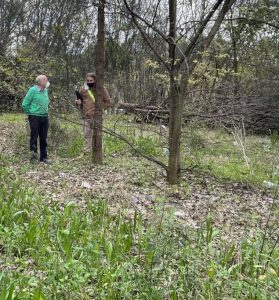Andrew Wood, Bulletin 7/2022, September

An onsite meeting was held at 8.30 am on 18 August 2022 at The Hill, a crown land site on the northern side of the Tramsheds. The meeting was organised by Cailin Martin, the City of Sydney’s Property Strategy Planner, and was also attended by Jacqui Brooks (Parks Assets and Services Manager), James Macnamara (Urban Ecology Coordinator), the President of the Glebe Society and four members of its Blue Wren Subcommittee, Kim Hague-Smith (Orphan School Creek Bushcare Group) and Professor Dieter Hochuli (University of Sydney).
As we know, The Hill was a garbage tip until about 1910, subsequently becoming a parking area for patrons attending the Harold Park races (trots and dogs) and is currently a fenced area of contaminated crown land.
On entering the site from the entrance at the junction of Maxwell Rd and Victoria Rd, about the first half of the central area is covered with bitumen related to its former use as a car park. There are thriving stands of lantana near this entrance and on the Tramsheds side of the site. The predominant tree, the deciduous Mediterranean hackberry (Celtis australis), is a noxious weed – saplings cover the site with mature trees on The Hill’s northern side and in the light rail corridor. A scattering of she-oaks (Casuarina spp) planted by volunteers in the late 1990s are present across the site. Enormous Port Jackson Figs (Ficus rubiginosa) are located on the southern side, adjacent to the Tramsheds, and many Canary Island Date Palms (Phoenix canariensis) are present on the steep western slope of The Hill.
Despite the large trees on the slopes and edges of the site, there’s a fair-sized open, sunny, central area, currently covered by mainly low-growing weeds and bits of rubbish – this could be an area suitable for future plantings of low-growing flowering plants to attract pollinators.
There is a lot of rubbish (pillows, bike parts and milk crates related to recent former camping sites) and assorted small piles of building rubble, all of which could be easily and speedily removed. The City needs to investigate a rectangular mound of stones at the site to see whether there is a pit underneath, the status of the old public path between The Hill and the Tramsheds, and whether there is a Sydney Water easement over a section of the site.

As far as bird life was concerned there were lots of noisy miners in the casuarinas, a kookaburra was heard in the Port Jackson Figs and a couple of butcher birds were seen flying very close by. Professor Hochuli said that native bees, butterflies and cicadas were also possible inhabitants of the site.
The inspection of The Hill demonstrated its great potential as an urban wildlife refuge once new plantings of native flora are established. The next step is for the Society, in collaboration with Professor Hochuli’s group at the University of Sydney, to apply for an Innovations and Ideas Grant from the City, which will enable the recording of wildlife presently using the site by the installation of cameras and acoustic recording devices.
In the future, this contaminated site could be covered with crushed sandstone as the planting medium – it is cheap and is the perfect medium for a large selection of flowering plants (wildflowers) that only grow in low nutrient soils.










One comment. Please add yours.
Great work